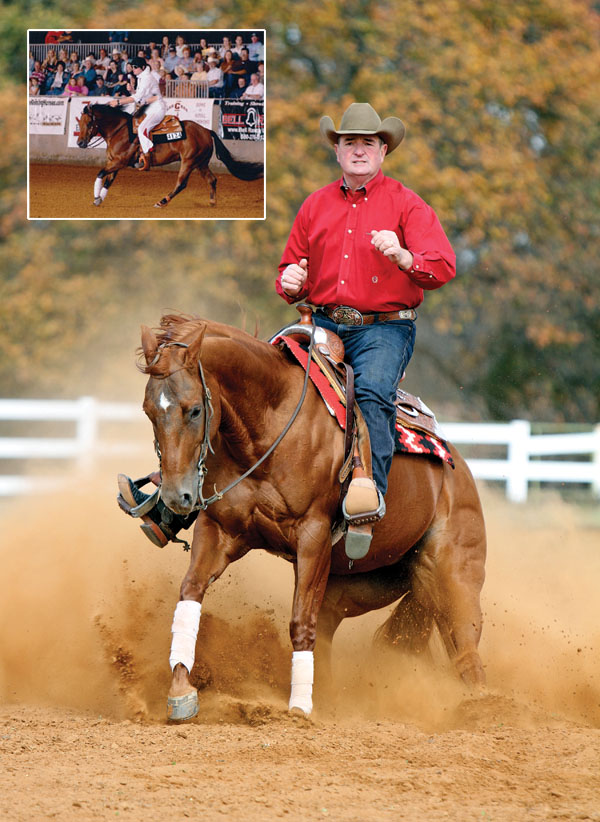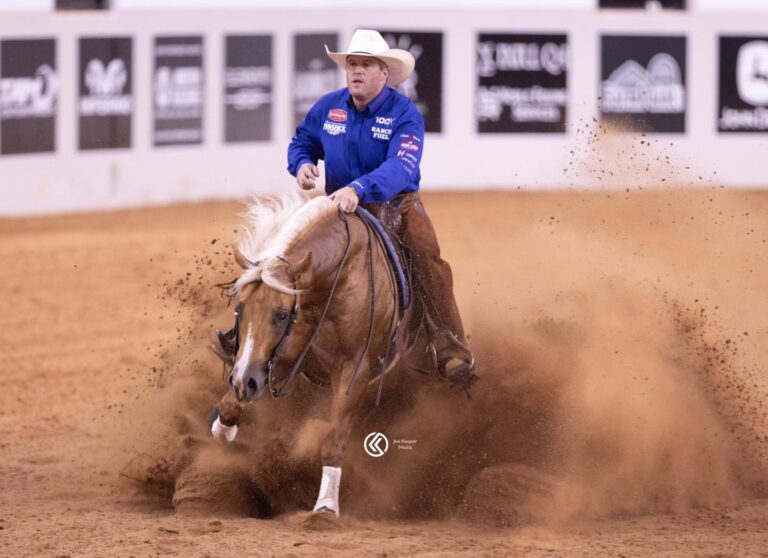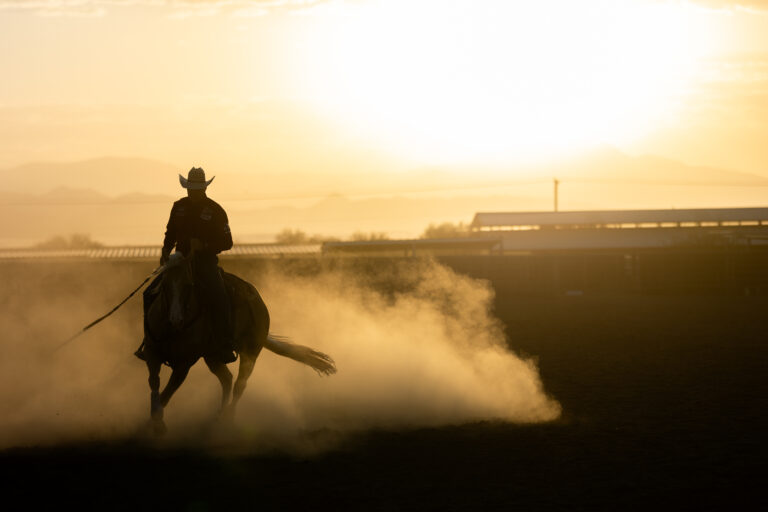Have you ever thought about competing in freestyle reining, but felt intimidated about choreographing your own routine and competing against pros? If so, this article is for you. I’m going to give you several pointers on choreographing a winning freestyle performance. I’ll also provide you with advice on how to perform specific maneuvers—some without reins—to give you an extra edge on the competition, whether it’s in an open or non-pro freestyle class.

Freestyle is also about having fun! It’s not only entertaining for spectators, it’s also rewarding and exciting for exhibitors. I enjoy competing in freestyle because it gives me the opportunity to devise a creative routine with required maneuvers instead of riding to set patterns. But even if you never intend to compete, this article will give you insights into how performances are scored. And who doesn’t enjoy watching an exciting freestyle run?
Music and Timing
Select your music before you choreograph your routine. The music may have certain “high” points that will be the best places for impressive maneuvers. Select a song you enjoy, and also consider what type of music will excite the audience. I don’t recommend heavy metal or rap music—these genres simply aren’t conducive to the flow of freestyle. A song with a good melody and a consistent rhythm is your best bet.
I did one of my personal favorite routines to “La Bamba,” wearing an oversized sombrero. It was a huge hit, because the song has a great beat and really excited the audience. →
You have up to 4 minutes to complete your routine. In my opinion, the ideal routine time is about 3 minutes and 30 seconds, or a little longer. During this time, try to work the entire arena without rushing any of your maneuvers, and don’t incorporate too many elements. This will only sacrifice the quality of your maneuvers.
Costume Considerations

While you’re not required to wear a costume, a fun ensemble can boost your overall creative score. Remember, freestyle is meant to be a fun experience for all, and a unique costume can really jazz up your routine.
Important: Your costume mustn’t inhibit your movement in the saddle, and if you outfit your horse in a costume, it shouldn’t prevent him from executing his maneuvers to the best of his ability. Also ensure that any headwear, such as a mask, doesn’t inhibit your vision. Your costume should be family-friendly—this is, after all, a family event.
Freestyle Fundamentals
While creativity is encouraged and rewarded in your routine, you’re required to execute the following maneuvers: a left and right lead change, three rundowns and stops, and at least four spins in both directions. The most important thing I can stress to you is to perform the required maneuvers to the best of your and your horse’s ability. Some riders focus more on the creative aspects of their routine, sacrificing the quality of their required maneuvers. This hurts their final score.
As you choreograph your routine, listen to your music multiple times (you should almost have it memorized), visualizing what maneuvers would be most effective at certain points in the song. For example, if there’s a big build-up in the music, a great stop could be an effective crowd pleaser.
The order of the required maneuvers doesn’t matter. Execute them in the order that makes sense to your music and routine. There are several things you can do to earn plus points on the required maneuvers, but if you don’t execute them well, those points won’t add up to much.
Also keep in mind that you can redo any required maneuver if you weren’t pleased with the quality of your first one. For example, if you executed a poor set of spins, incorporate another set (in the same direction) somewhere else in your routine. On the other hand, if you executed stellar spins, then don’t do another set later in the same direction. You already nailed it and got your points!

Required Maneuvers
Spins: You must demonstrate a minimum of four well-executed spins in both directions, left and right. While you must do a minimum of four turns, don’t hesitate to do more if all is going well.
Lead changes: You can incorporate the two required lead changes anywhere in your routine; you don’t have to do them in the middle of the arena as you do in a typical reining pattern. Execute your changes where you’re confident your horse will get them.
If my horse happens to be a great lead changer, I’ll lope him down the center (or the diagonal) of the arena and do three, four, or even five changes in a row—so it almost looks like he’s skipping. If your horse is mediocre at his changes, simply execute a nice, accurate change in each direction. In this case, I suggest making your changes on a straight line through the middle of the arena to give yourself plenty of time to set your horse up correctly for the change.
Rundowns and stops: In freestyle, you can do your three required rundowns/stops anywhere in your pattern. I like to change up where I do my rundowns; for example, I’ll run down a diagonal of the arena. This not only spices up your routine, but also encourages your horse to pay closer attention to your cues, because he doesn’t know what you’re going to ask of him next. As a result, your horse will be more in tune with you and build up his speed nicely in a controlled manner. Conversely, when you execute multiple rundowns in the middle of the arena, your horse may begin to anticipate the maneuver, which can result in a poor, unattractive stop.
Other Maneuvers

Circles: As long as you can nail the required elements, there are several maneuvers you can incorporate to gain bonus points. For example, I always perform a few circles in my routines: large, fast circles and small, slow ones. The change from one to the other can be impressive. (Note: Almost every horse circles better in one direction than the other, so I suggest you only perform your horse’s best set of circles. Since this isn’t a required maneuver, show your horse off to the best of his ability.)
Rollbacks: In freestyle, rollbacks aren’t required, so there’s no reason to do one if your horse isn’t good at them. But if he is, that’s something to show off.
Two-tracking: If your horse yields well to leg pressure and can produce fluid lateral motion, consider incorporating the two-track into your routine. This maneuver can be very effective and crowd-pleasing, especially to certain types of music. If your horse doesn’t two-track well in one direction, only choreograph it to his “good” side.
Backing up: A well-executed back-up is always a good maneuver to incorporate when seeking bonus points. After a stop, or at the end of your routine, a straight, cadenced back-up is impressive.
Hands-Free Riding

Many freestyle riders add a little “awe” to their routines by dropping their reins during maneuvers. Riding without reins takes an advanced degree of skill and isn’t something you should attempt for the first time in a show arena surrounded by loud, cheering fans. But if you’ve practiced and are confident in your horse’s responsiveness, doing part of your routine hands-free can net you bonus points. Here are some key tips.
To ride hands-free, you must use a single rein instead of split reins, so you can place it over your saddle horn to prevent it from sliding up your horse’s neck—or worse—falling over his head. The length of your rein should be appropriate to the length of your horse’s neck, so it just fits over the saddle horn. If it’s too short, it’ll pull on your horse’s mouth. If it’s too long, it could slip off the horn. (Note: It’s acceptable to use a snaffle or a shank bit with a single rein.)
Before you go hands-free in your spins, be sure you’ve established a correct maneuver. Set your horse up straight and square, and be slow to start to allow your horse to “feel” that turnaround—then allow him to achieve his maximum speed.
Once your horse is into the spin sequence, gently place your rein over the horn and continue. Stay in the center of your horse, and slightly twist with his body. When you twist, don’t contort your body away from your horse’s movement. Simply turn with his body to a slight degree, so you’re moving together. Don’t lean to the inside or outside. If you lean either direction, it’s going to affect the quality of your horse’s spins, because your horse will become unbalanced due to your uneven weight distribution.
Once you’ve dropped your rein, raise your hands straight up or out to your sides—like an airplane. Or, get creative by making a fun motion with your hands, such as firing imaginary guns or waving. The key is to make it look natural and fun. But make sure your hand or arm movement doesn’t affect your upper body motion to the point it detracts from the quality of your turn.
Keep in mind that it’s challenging to maintain precise circles without reins. Practice your circles at home by loosening up your reins, so you have little or no contact, and make sure your hand is directly in the middle of your horse’s neck. It shouldn’t drift to the right or left. With your hand right in the center of your horse’s neck, neither of your reins is giving him direction. If your horse begins to lean in or out, correct him with your reins, then put your hand back in the center of his neck.
When circling without reins, maintain close contact with your legs, so if, for example, your horse starts to drift to the inside, you can easily squeeze with your inside leg to push him back out. If your horse starts to drift to the outside, simply apply pressure with your outside leg to push him back in. Furthermore, always look where you’re going—about a quarter of a circle ahead of you, and aim to come back to the same place in which you began your circle.
To transition to smaller, slow circles without reins, sit down deep in your saddle, take your inside leg off your horse, and push your weight down. Your horse will learn to react to your body cues, rather than your hand.
To do a hands-free stop, gradually build your speed while making sure your horse is balanced. As you cue him to stop, pay careful attention to your body position and motion. Sit deep in your saddle and move your legs away from your horse’s sides.
As you stop, subtly place your rein around the horn and raise your hands. Be attentive to your seat position; many riders will sit down nice and deep, but when they stop and raise their hands, they lift their bodies up out of the saddle. If you raise your body, your horse will likely follow your motion and come out of his stop.
If your horse doesn’t do a nice rollback after your stop, simply don’t do one. Instead, settle yourself and your horse, walk forward a few steps, and pick up your lope in the other direction—then run down the other diagonal for a nice stop.
If your horse is extremely responsive to your leg cues, consider backing up without reins to really make the audience go wild. When backing without reins, remember to sit straight, in the middle of your saddle, and apply equal pressure with your legs to keep your horse’s body straight and square.
Final Note
While I encourage you to gain points by incorporating the “extra-credit” maneuvers I discussed above, don’t get too risky. By this, I mean don’t try a maneuver you’re not 100-percent confident that you and your horse can perform well—and safely.
Focus on incorporating as much creativity as you can, and above all, have fun!
Pete Kyle, Whitesboro, Texas, specializes in training horses for standard reining competition, as well as freestyle, and has coached numerous youth and amateur riders to world championship titles. He’s won world championships in six associations and was a top-10 money earner for the NRHA in 2012. Besides winning the NRHA open world championship in 2001 aboard Dun It The Hard Way, he’s also a five-time USEF gold medal winner in freestyle competition.






